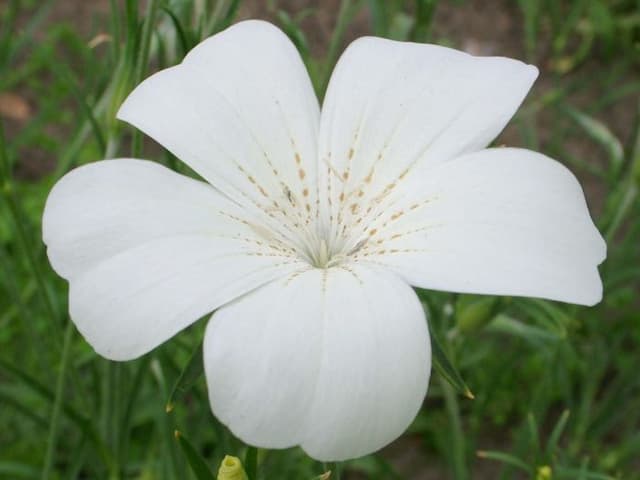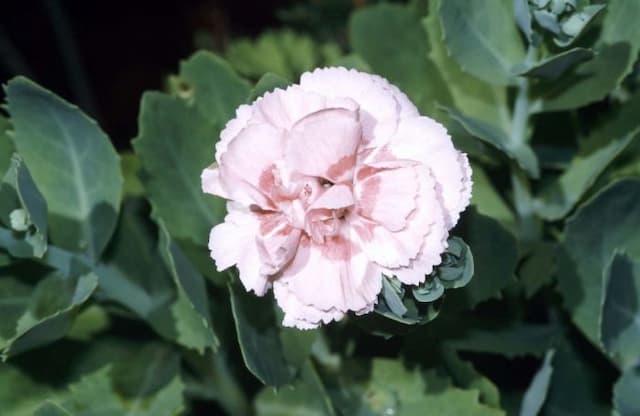Pink Dianthus 'Sandra Neal' (b)

ABOUT
The Dianthus 'Sandra Neal' is a charming plant known for its distinctive flowers and foliage. The blooms are a standout feature, with a frilly or serrated edge that gives them a feathery look. These flowers are typically pink, exuding a subtle yet refreshing fragrance that can be noticed when close to the plant. The petals may exhibit varying shades of pink and sometimes have a patterned appearance with lighter or darker accents at their edges, providing a delightful contrast against the greenery. The leaves of the Dianthus 'Sandra Neal' present another layer of texture and color. They are narrow and elongated, resembling slender blades that come together to form dense tufts or mounds. The foliage is typically blue-green to gray-green, offering a cool-toned backdrop that further accentuates the bright flowers. This foliage coloration can also provide a lovely contrast against the richer greens commonly found in garden settings, making the Dianthus 'Sandra Neal' a visually appealing addition to a variety of landscapes. Overall, the aesthetic of this plant is one of neatness and compactness, with its characteristic flowers and foliage creating a picturesque display. The Dianthus 'Sandra Neal' is cherished by gardeners and flower enthusiasts for its endearing beauty and the vibrant touch it adds to beds, borders, and containers.
About this plant
 Names
NamesFamily
Caryophyllaceae
Synonyms
Sandra Neal Pinks, Sandra Neal Dianthus, Sandra Neal Carnation, Sandra Neal Sweet William
Common names
Dianthus 'Sandra Neal'
 Toxicity
ToxicityTo humans
The plant commonly known as Carnation, specifically the Dianthus 'Sandra Neal', is generally not considered toxic to humans. However, if ingested in large quantities, it could potentially cause mild gastrointestinal discomfort, including nausea and vomiting. Accidental ingestion of small amounts is unlikely to cause serious harm, but it is advisable to avoid consuming any part of ornamental plants.
To pets
Carnations, including the variety Dianthus 'Sandra Neal', are considered to be mildly toxic to pets, particularly cats and dogs. If a pet ingests part of a Carnation, symptoms of poisoning may include gastrointestinal upset such as vomiting or diarrhea. While the toxicity is typically low, it's still recommended to keep this plant out of reach of pets and to seek veterinary care if you suspect your pet has ingested a significant amount.
 Characteristics
CharacteristicsLife cycle
Perennials
Foliage type
Evergreen
Color of leaves
Blue-green
Flower color
Pink
Height
1 foot 4 inches (40 cm)
Spread
1 foot (30 cm)
Plant type
Herb
Hardiness zones
6
Native area
Europe
Benefits
 General Benefits
General Benefits- Aesthetic Appeal: Dianthus 'Sandra' boasts beautiful pink, fringed flowers that add color and visual interest to gardens and landscapes.
- Fragrance: The flowers emit a sweet, spicy scent that can be enjoyed when planted in close proximity to outdoor living areas.
- Attracts Pollinators: Dianthus flowers attract butterflies and bees, which are important pollinators for your garden and the environment.
- Long Blooming Season: Dianthus 'Sandra' typically has a long flowering period, providing color and vibrancy throughout the growing season.
- Low Maintenance: This plant is known to be low maintenance, requiring minimal care once established, and is fairly drought-tolerant.
- Versatility: It can be used in a variety of garden settings, including borders, rock gardens, and containers.
- Cut Flowers: The blooms of Dianthus 'Sandra' make excellent cut flowers for indoor arrangements, often lasting well in vases.
 Medical Properties
Medical PropertiesThis plant is not used for medical purposes.
 Air-purifying Qualities
Air-purifying QualitiesThis plant is not specifically known for air purifying qualities.
 Other Uses
Other Uses- Carnation 'Sandra Neal' petals can be crystallized and used as edible decorations on cakes and desserts, providing a touch of natural beauty and a slight spicy taste.
- The strong structure of carnation flowers allows them to be used in crafting, such as creating natural flower crowns or boutonnieres for weddings and other celebrations.
- Carnation petals can be incorporated into potpourri mixes for a visually appealing and subtly fragrant addition to home décor.
- These flowers can be used as natural dye sources, providing shades of pink and red depending on the mordant used.
- Carnation blooms can serve as a muse for artists and photographers, inspiring paintings, drawings, and photographic projects with their intricate layers and vibrant colors.
- Their long-lasting nature when cut makes carnations practical for long-term displays in public spaces and event settings.
- Carnation petals can be pressed and included in handmade paper, creating textured and visually interesting stationery or gift wrap.
- The flowers of the carnation can be used to infuse oils or vinegars, adding a subtle spice to culinary creations.
- They can be a natural repellent for some insects, due to their clove-like scent, when planted in gardens or placed in arrangements.
- Carnation blooms are sometimes used in aromatherapy practices for their traditional association with feelings of love and fascination.
Interesting Facts
 Feng Shui
Feng ShuiThe plant Carnation is not used in Feng Shui practice.
 Zodiac Sign Compitability
Zodiac Sign CompitabilityThe plant Carnation is not used in astrology practice.
 Plant Symbolism
Plant Symbolism- Love: Dianthus is frequently associated with love, as its name refers to the "flower of the gods" from the ancient Greek dios (god) and anthos (flower), often connected with divine love.
- Affection: Throughout history, dianthus has been used to convey affection and deep personal sentiments.
- Admiration: The bright and lively colors of the Dianthus 'Sandra' signify admiration and are often used to express high esteem and sincere respect.
- Pure Love: The delicate and sweet nature of dianthus blossoms symbolize pure love, showcasing innocence and genuine emotion.
 Water
WaterDianthus, commonly known as 'Pinks' or 'Carnation', prefers to be kept evenly moist but not waterlogged. They should be watered thoroughly whenever the top inch of soil feels dry to the touch. Typically, this could be once or twice a week, depending on climate conditions, but always check the soil moisture level before watering. When watering, apply water directly to the base of the plant to avoid wetting the foliage, which can lead to fungal diseases. In terms of quantity, for a plant in a standard garden setting, roughly one to two gallons spread out over a week should suffice, ensuring the soil is hydrated but well-drained.
 Light
LightCarnations thrive in full sunlight, meaning they prefer at least six hours of direct sunlight each day. They will perform best when placed in a location where they can receive plenty of morning sunlight, which is less intense and helps avoid afternoon heat stress. They can tolerate some light afternoon shade, especially in hotter climates, which will help protect them from scorching during peak summer temperatures.
 Temperature
TemperatureCarnations enjoy cool to moderate temperatures and can tolerate a temperature range from approximately 40°F as a minimum to about 85°F as a maximum. The ideal temperature for growing Carnations would be between 60°F and 70°F. They are hardy in cooler conditions but will need protection from frost which can be damaging if temperatures drop below the minimum range.
 Pruning
PruningPruning carnations is essential to promote bushy growth, remove spent blooms, and maintain the plant's shape. Deadheading, or the removal of faded flowers, should be done regularly throughout the blooming season to encourage more blooms. In the spring, cut back any winter-damaged stems to healthy new growth. The best time for more extensive pruning is in the early spring or just after the main bloom period to allow time for regrowth and additional flowering.
 Cleaning
CleaningAs needed
 Soil
SoilCarnations prefer well-drained, neutral to slightly alkaline soil with a pH of 6.7 to 7.5. A mix of loam, compost, and coarse sand is ideal to ensure proper drainage and fertility.
 Repotting
RepottingCarnations, including the 'Sandra Neal' variety, generally require repotting every 2 to 3 years to refresh the soil and accommodate root growth.
 Humidity & Misting
Humidity & MistingCarnations thrive best in environments with moderate humidity and do not require excessively high humidity levels.
 Suitable locations
Suitable locationsIndoor
Place in bright, indirect light and ensure good air circulation.
Outdoor
Plant in full sun with well-draining soil and space for air flow.
Hardiness zone
4-9 USDA
 Life cycle
Life cycleThe life of Dianthus 'Sandra' typically begins with seed germination, which occurs when the seeds are sown in moist soil and provided with proper light and temperature conditions. As they germinate and grow, the seedlings develop into young plants with characteristic grass-like foliage. Through the vegetative stage, the plants continue to grow and produce more leaves, preparing for the flowering stage. Flowering occurs in late spring to early summer, when Dianthus 'Sandra' produces its distinct fragrant flowers, often used for ornamental purposes. After pollination, possibly by insects, the flowers will develop into seed capsules containing numerous tiny seeds for reproduction. Dianthus 'Sandra' is a perennial, so after the flowering season, it will typically go dormant in the winter, resuming growth in the spring while maintaining the root system for several years.
 Propogation
PropogationPropogation time
Spring to Summer
Dianthus 'Sandra Neal', commonly known as Pink, is most commonly propagated through stem cuttings. To propagate using this method, gardeners take a cutting from a healthy, non-flowering stem, ideally in late spring or early summer when the plant's growth is most vigorous. The cutting should be about 4 to 6 inches (roughly 10 to 15 centimeters) long, with several sets of leaves. The lower leaves are removed, and the cut end is often dipped in a rooting hormone to encourage root growth before it is planted in a well-draining soil mix. The cutting is then kept moist but not waterlogged, and in a bright area without direct sunlight until roots have developed, which generally takes a few weeks. Once roots are established, the cutting can be transplanted into the garden or a permanent container.








![Pink [Bubblegum]](/_next/image?url=https%3A%2F%2Fplants-admin.emdemapps.com%2Fimages%2Fplants%2F%2Fimages%2F604b596f31cbb.png&w=640&q=75)
